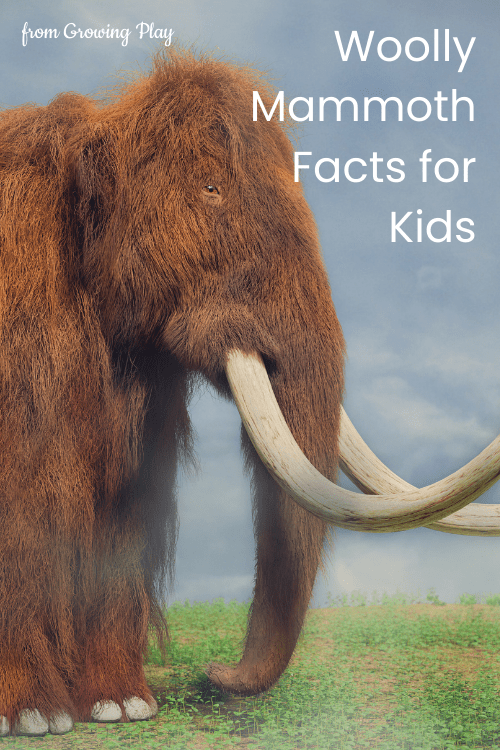Woolly Mammoth Facts for Kids

Have you ever heard of woolly mammoths? You may not have since woolly mammoths went extinct around 10,000 years ago. But, if you do know what a woolly mammoth is, that’s great! They were big, furry creatures with long tusks and a humped back, kind of like modern elephants. If you’ve ever seen the Ice Age movies, you’ve seen depictions of a woolly mammoth. Woolly mammoths replicas can also be found in many museums around the world. So, let’s learn more about what these fascinating creatures looked like, acted like, and were treated like. Keep reading to learn all the woolly mammoth facts for kids from their size and habitats to their diets and characteristics.
What Did the Woolly Mammoth Look Like?
1. The woolly mammoth was described for the first time by Georges Cuvier in 1796.
2. Woolly mammoths had a thick coat of fur to keep them warm in the high arctic temperatures and permafrost of the arctic. They actually had two layers of fur – an outer layer of long guard hairs and an inner layer of shorter, softer hairs. Underneath all this fur was a thick layer of fat to keep the animals even warmer in the cold climate. Having shaggy coats is one way the woolly mammoths adapted to the colder climates. What do you wear when it’s cold out?
3. Depictions of mammoths show them to have had long, curved tusks and a humped back. Woolly mammoth tusks were thought to be made of mammoth ivory, which was very similar to elephant ivory. This is why many people compare woolly mammoth species to modern Asian Elephants and the African Elephant. What other similarities do you notice between the physical appearance of these two animals?
Woolly Mammoth Facts for Kids – Woolly Mammoths and Today’s Elephants
4. The woolly mammoth was closely related to the modern elephant. The largest species of mammoth were of similar size to the large mammal elephants. The Steppe Mammoth or Mammoth Steppe was the largest known mammoth species, with an average height of 4.5 meters. Similarly, African Elephants could grow up to 4 meters. Mammoth tusks alone could grow over 3 meters! Can you get an idea of just how big these creatures were?
5. Woolly mammoths had smaller ears and shorter tails than elephants, but other than that, they were pretty much exact replicas (minus the fur of course).
Where in the World Were the Woolly Mammoths?
6. Woolly mammoth populations ranged across Southern Europe, Northern Eurasia, North America, South America, and the Arctic. Mammoth bones have been found on Wrangel Island in the Arctic Ocean, in areas of the North Pole, and across several continents. This hints at the fact that the continents were once connected during the Ice Age.
Woolly Mammoth Characteristics
7. The woolly mammoth lived in herds mainly along grasslands and icy habitats.
8. Woolly mammoths primarily fed on grasses, shrubs, and tree bark. Despite their size, they rarely ate meat. Believe it or not, their main food sources came from plants, making the woolly mammoths herbivores. This is another way in which the species was similar to the elephants.

Dinosaur Puzzles and Games for Kids
More Interesting Woolly Mammoth Facts for Kids
9. The woolly mammoth was named after its woolly coat. The official name of the species was Mammuthus Primigenius. Try saying that three times fast!
10. The woolly mammoth was one of the largest animals to have ever lived and is one of the most famous prehistoric animals. The species is an iconic symbol of the Ice Age. Have you ever seen the Ice Age movies? Manny is the main woolly mammoth in the Ice Age series and later on we meet Peaches, the baby mammoth in the movie.

Dinosaur Puzzle Game
Woolly Mammoth Fossils
11. Woolly mammoths were one of the last surviving members of the Pleistocene megafauna.
12. According to the fossil record, the last woolly mammoths lived over 10,000 years ago, although some could have survived until as recently as 4,000 years ago. Today, they are an extinct species, meaning there are no more woolly mammoths left in the world.
13. The woolly mammoth became extinct due to climate change and overhunting. The woolly mammoths were hunted by the early humans for its meat and fur.
14. Some scientists believe that the woolly mammoth could be resurrected through cloning. In fact, a team of Japanese and Russian scientists are working on a project to clone a woolly mammoth. Would you want more woolly mammoths roaming around?
WANT MORE FUN FACTS FOR KIDS?
Check out these fun facts for kids here and browse all the other topics at the bottom of the post.



